Violence and abuses: 2024 one of the deadliest years since ’71
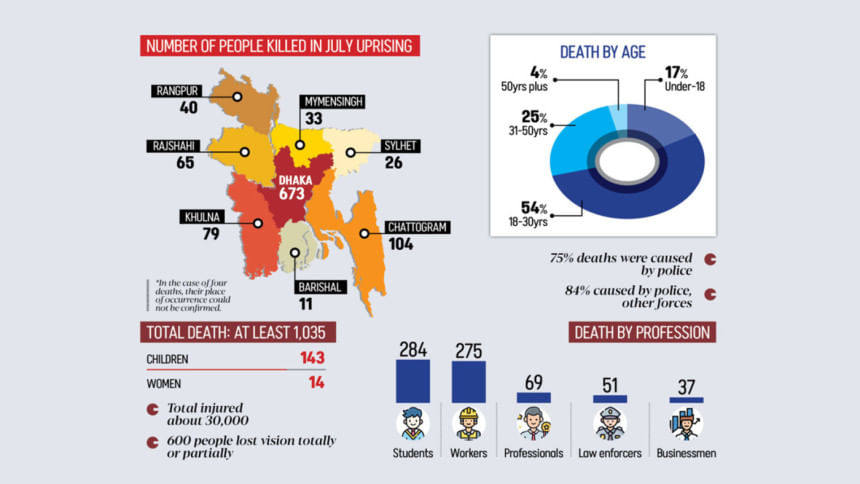
Twenty twenty-four, "one of the deadliest and most violent years since the independence war of Bangladesh", was marked by killings, enforced disappearances, and brutal attacks on civilians, according to the Human Rights Support Society.
In its annual report released yesterday, the group said it recorded at least 1,180 political killings and 37,051 people being injured nationwide last year.
The July–August uprising alone claimed 1,035 lives, said the Human Rights Support Society (HRSS).
The HRSS compiled the data of deaths based on their places of occurrence. The toll it confirmed includes four killings, of which the HRSS could not determine the scene.
At least 673 of these killings were in Dhaka division.
The rights group added it is still working on the death toll of the July uprising and its estimate exceeds 1,300.
Compiled from 12 national media outlets as well as testimonies of victims' families, eyewitnesses, and hospitals, the report painted a grim picture of the year in two phases: the final months of Sheikh Hasina's regime and the turbulent aftermath of her departure.
It found that in just seven days, July 18-20 and August 4–7, at least 890 people were killed, including 309 on August 5, the day Hasina fled.
Many of the victims, buried as unidentified, were not included in the report.
Of the killings documented, 520 or 75 percent died due to police atrocities, according to the HRSS report. It found that more than 84 percent of protest-related fatalities were caused by police and other security forces.
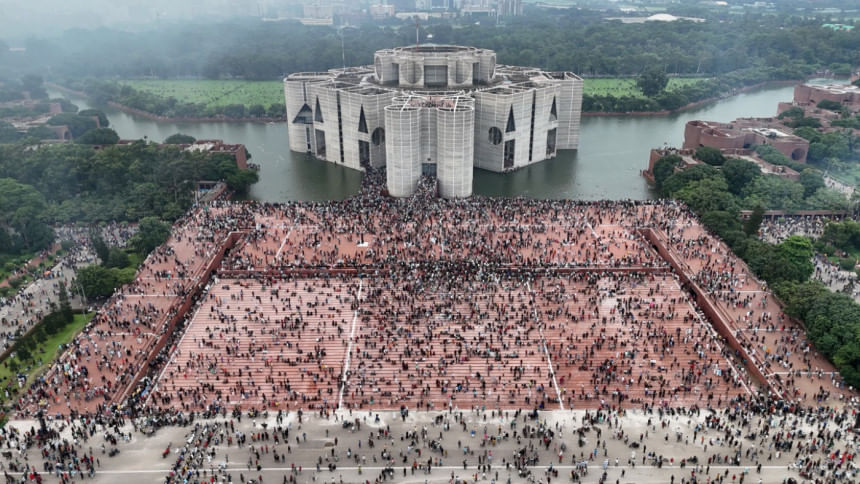
The violence left at least 30,000 people injured, including thousands who lost limbs or eyesight. Over 600 people lost vision in one or both eyes.
The victims included students, labourers, journalists, professionals, law enforcers, children, women, and political activists.
Among the dead, 143 were children and adolescents, and 14 were girls or women.
Of 855 identified victims, 17 percent were under 18, 54 percent young adults, 24 percent middle-aged, and 4 percent elderly.
Strikingly, 71 percent of those whose ages were known were under 30.
Journalists faced severe risks in 2024, with at least 309 attacks affecting 727 media workers. Nine were killed, 370 injured, 109 assaulted, 95 threatened, 19 arrested, and 134 sued.
During the July–August protests, at least 270 journalists were assaulted, arrested, or threatened on duty, including six who were killed.
HRSS Executive Director Ijajul Islam said police and security forces were the main perpetrators of rights violations, yet no effective measures were taken by the interim government.
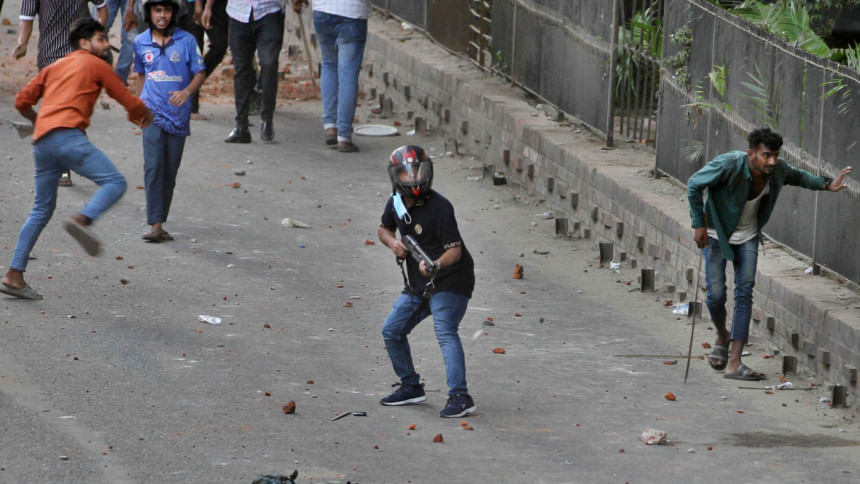
Such action should not be postponed until the next elected government, he said.
Ijajul added, "Over the past 15 years, members of the forces involved in human rights violations have often received promotions or been reassigned. In particular, those responsible for the killings during the July–August protests should have faced legal proceedings, but this was not carried out promptly.
"There remains a significant gap in implementing the Police Reform Commission's recommendations."
Between July 17 and August 4, more than 950 cases were filed, implicating over 600,000 people and leading to 12,000 arrests, according to the HRSS report.
In the chaos that followed Hasina's resignation, more than 500 police stations, outposts and government offices were attacked, vandalised or torched. Nearly 2,000 houses, vehicles and businesses were looted or destroyed, the report said.

Minority communities also came under attack: 65 incidents left two people dead, 61 injured, and damaged 15 temples, 228 homes, and 240 shops.
HRSS documented at least 3,407 incidents of political violence in 2024, resulting in 1,180 deaths and 37,051 injuries, including in the July-August protests. More than 15,500 leaders and activists, mostly from BNP-Jamaat and Awami League, were arrested. Authorities filed 1,383 cases implicating at least 66,000 individuals and another 660,000 unnamed suspects.
Opposition rallies were frequently disrupted: more than 700 events left 30,000 injured and 10,000 arrested.
The 12th National Parliamentary Election and the 6th Upazila Parishad Election were marred by violence, low turnout, and boycotts. A total of 781 incidents of electoral violence left 43 dead, including 39 Awami League supporters, and 2,538 injured. More than 820 homes and businesses were damaged.
Seventeen people were killed and over 2,500 injured during the parliamentary polls alone. The upazila polls saw 203 violent incidents, 17 deaths, and more than 1,000 injuries.
Violence against women and children remained alarming. In 2024, 1,499 women and girls were attacked, including in 558 rape incidents. As many as 284 of these incidents involved minors. Of these, 130 were gang-rapes.
Forty victims, including 22 children, were killed afterwards while 11 survivors died by suicide.
Another 322 women and children faced sexual harassment.
Domestic violence claimed 319 lives, while dowry-related violence killed 48 women and acid attacks left 13 injured.
Domestic violence claimed 319 lives, injured 74 women, and led 127 to die by suicide, while dowry-related violence left 48 women dead, 32 physically assaulted, and six to die by suicide. Thirteen were victims of acid attacks.
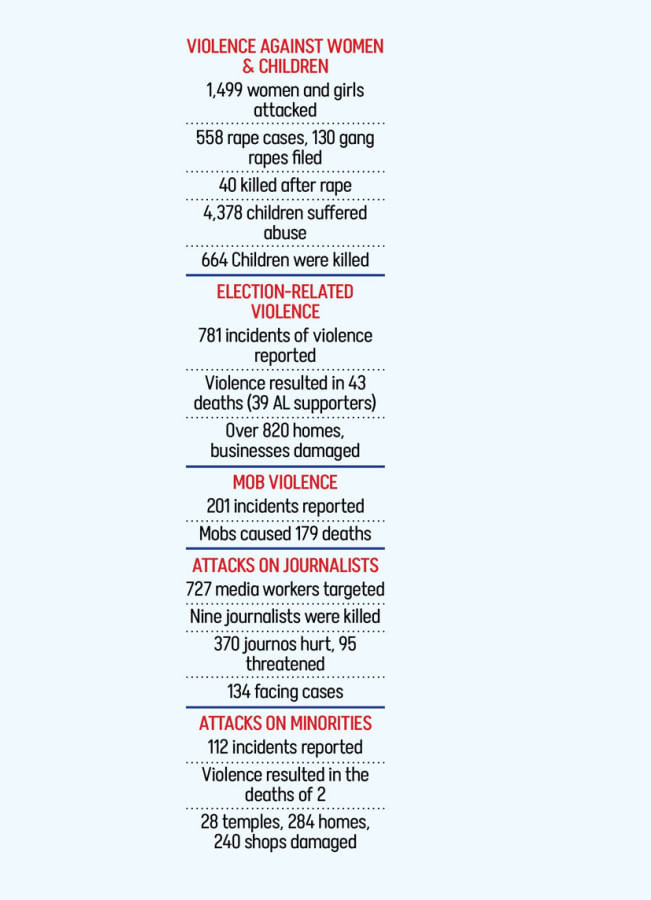
At least 4,378 children suffered abuse, resulting in 664 deaths. The July–August protests alone left 143 children dead and more than 3,000 injured.
Ijajul noted that limited media coverage during the uprising meant many incidents went unreported. "Many incidents did occur, but the published data did not fully capture them," he said.
He added that only 2–3 percent of rape and abuse cases are prosecuted, often taking decades to resolve, with perpetrators shielded by influence and social barriers.
The HRSS report also recorded 32 Cyber Security Act cases against 79 individuals. These cases saw 21 arrests.
Its other findings include a total of 112 incidents of attacks on minorities that left two killed and 83 injured, while 28 temples and 284 homes were damaged.
In 201 incidents of mob violence, 179 were killed and 88 injured.
Labour exploitation caused 439 deaths, including 240 by law enforcement gunfire, according to the HRSS report.
Workplace accidents left 168 dead while nine deaths and four injuries occurred from domestic worker abuse.
At the borders, 32 were killed and 50 injured in incidents involving India's BSF and Myanmar's forces.
HRSS reported 25 extrajudicial killings linked to law enforcement agencies and 102 deaths in prisons.
In its report, the rights group urged the government to hold perpetrators of extrajudicial killings and enforced disappearances accountable, ensure free and fair elections through an independent Election Commission, reform the judiciary, and protect journalists and rights defenders.
It further called for stronger safeguards for women, children, and minorities; improved prison and labour conditions; repeal of restrictive laws; and greater transparency and accountability in law enforcement and border management, alongside truth, reconciliation, and long-term social cohesion.


 For all latest news, follow The Daily Star's Google News channel.
For all latest news, follow The Daily Star's Google News channel. 
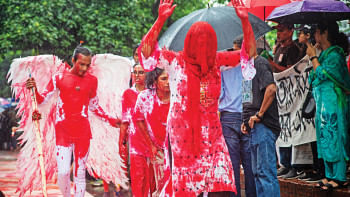



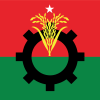
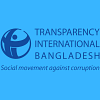


Comments